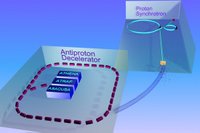CERN Anti-matter Particle Beam Obliterates Living Cells
 For the past three years, scientists at CERN have been experimenting with anti-proton beams and their effect on living cells. They have discovered that anti-proton beams are four times more deadly to living tissue than proton beams. This discovery offers promise of safer and more effective treatments for cancer.
For the past three years, scientists at CERN have been experimenting with anti-proton beams and their effect on living cells. They have discovered that anti-proton beams are four times more deadly to living tissue than proton beams. This discovery offers promise of safer and more effective treatments for cancer.Current particle beam therapy commonly uses protons to destroy tumour cells inside a patient. The ACE experiment directly compared the effectiveness of cell irradiation using protons and antiprotons. To simulate a cross-section of tissue inside a body, tubes were filled with hamster cells suspended in gelatine. Researchers sent a beam of protons or antiprotons with a range of 2 cm depth into one end of the tube, and evaluated the fraction of surviving cells after irradiation along the path of the beam.Source.
The results showed that antiprotons were four times more effective than protons. When comparing a beam of antiprotons with a beam of protons that cause identical damage at the entrance to the target, the experiment found the damage to cells inflicted at the end of the beam path to be four times higher for antiprotons than for protons. Michael Holzscheiter, spokesperson of the ACE experiment, summarises: “To achieve the same level of damage to cells at the target area one needs four times fewer antiprotons than protons. This significantly reduces the damage to the cells along the entrance channel of the beam for antiprotons compared to protons. Due to the antiproton's unsurpassed ability to preserve healthy tissue while causing damage to a specific area, this type of beam could be highly valuable in treating cases of recurring cancer, where this property is vital.”
Antiprotons are antimatter; they have to be produced in small amounts in a laboratory with the help of a particle accelerator. When matter and antimatter particles meet, they annihilate, or destroy each other, transforming their mass into energy. The experiment makes use of this property as the antiproton would annihilate with a part of the nucleus of an atom in a tumour cell. The fragments produced from the energy released by the annihilation would be projected into adjacent tumour cells, which are in turn destroyed.
Proton beams have been put to good use treating prostate cancer and other cancers. If anti-proton beams are even more effective, with less incidental normal tissue destruction, the new treatment would contribute to both quantity and quality of life.
This is still a case of swatting flies with sledge-hammers, but at least we will be swinging the hammers with a bit more finesse. Newer methods of programming viruses, bacteria, and immune cells to target cancers would seem to be much more potentially accessible methods of cancer treatment for patients all around the world. Even so, it is good to put multi-billion dollar physics facility to the use of saving lives.
Labels: cancer

1 Comments:
A favourable therapy for prostate cancer has arrived named Proton Beam Therapy. It has been suggested that it is a viable choice among prostate cancer patients with diminutive chances of any side effects to the urinary and rectal functioning. This therapy is becoming very popular. For more information on it, refer Proton beam therapy for prostate cancer
Post a Comment
“During times of universal deceit, telling the truth becomes a revolutionary act” _George Orwell
<< Home